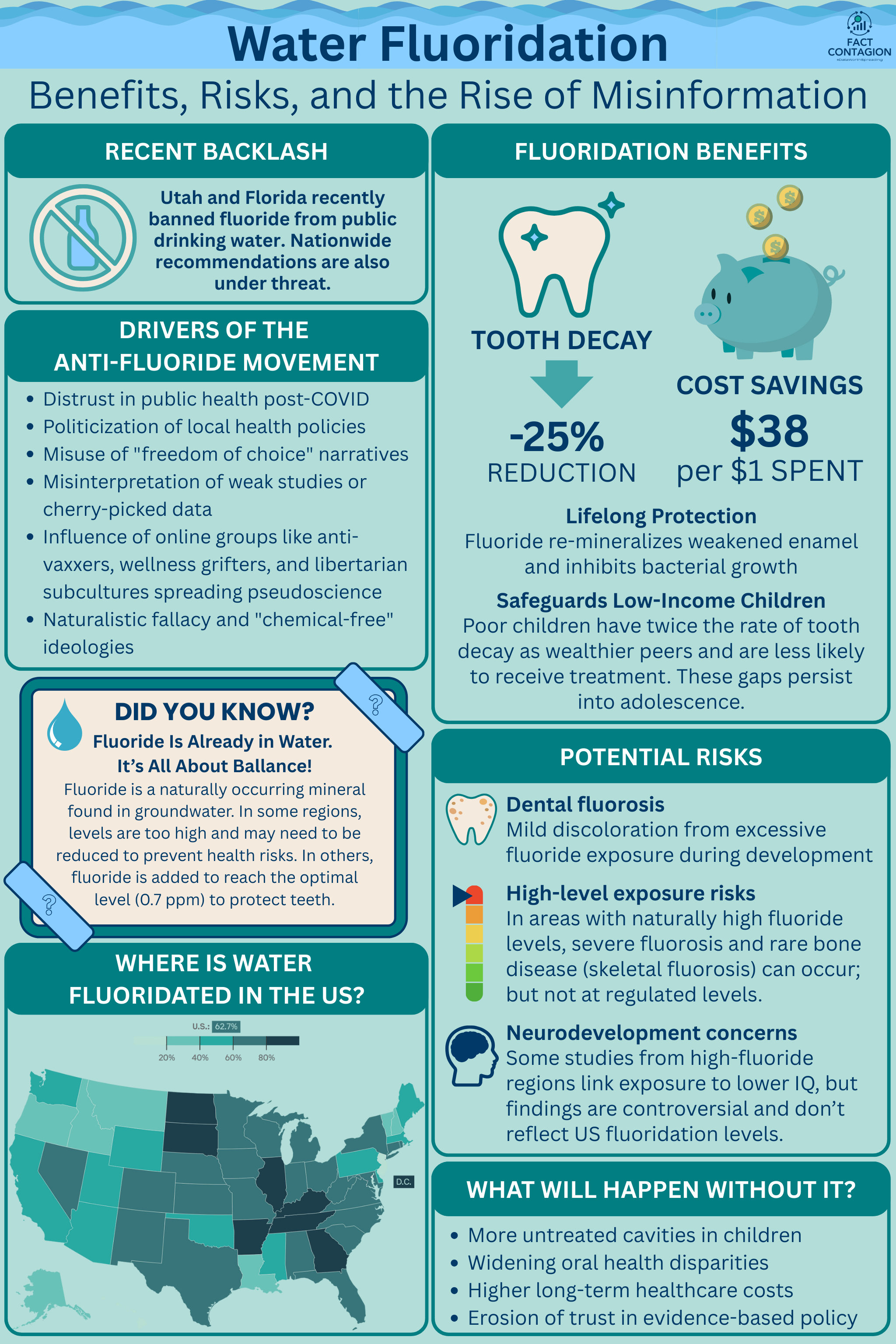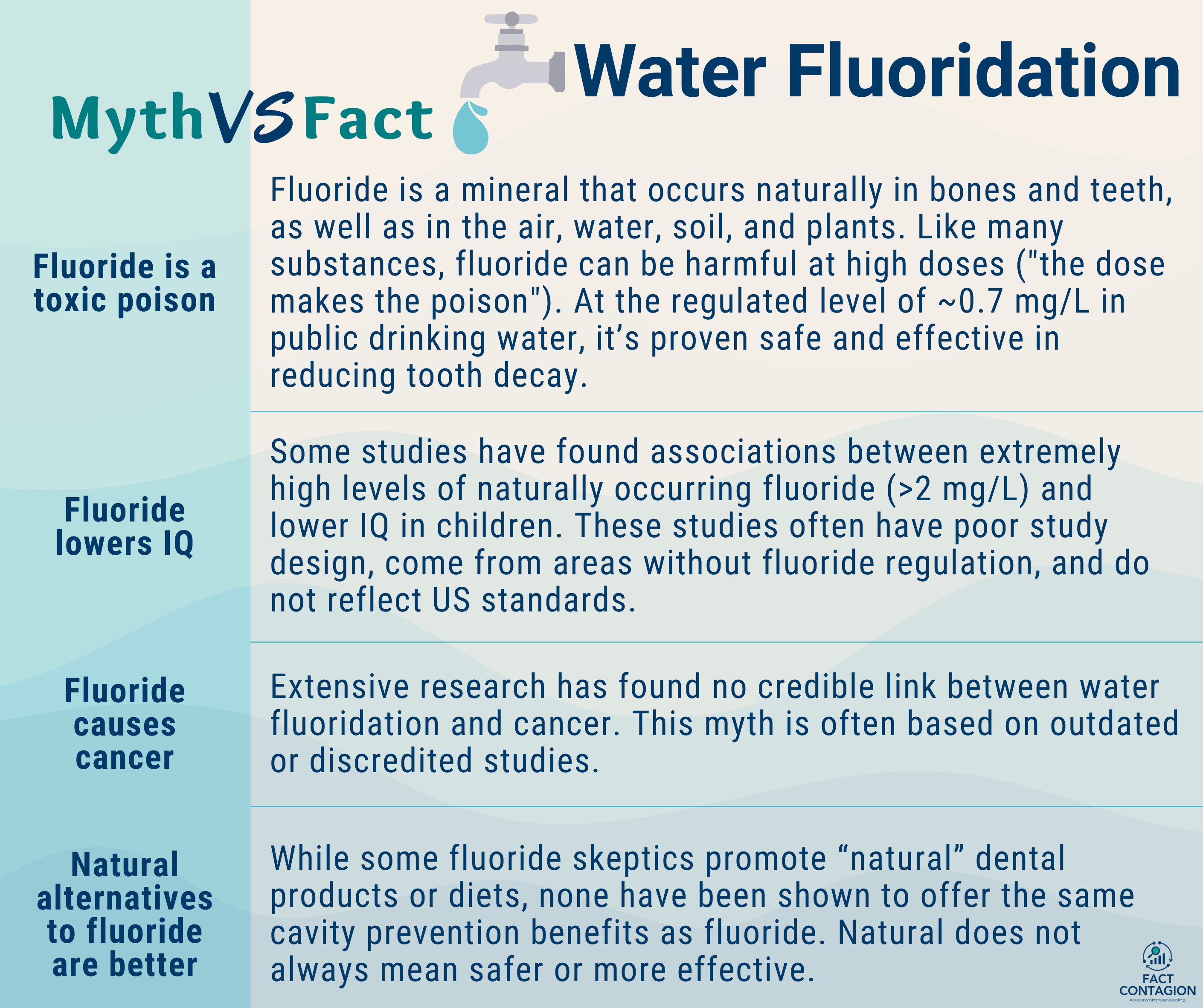Water Fluoridation Under Attack: The Science, Misinformation, and What’s at Stake

For nearly 80 years, fluoridated drinking water has protected millions of Americans from painful, expensive tooth decay. Especially those living in communities with the fewest resources. It's cheap. It's effective. It's endorsed by every major health authority, from the CDC to the WHO.
And now? It’s under attack. Critics argue it's a matter of personal liberty and an unnecessary, even inappropriate, and perhaps harmful form of mass medication.
In March, Utah became the first US state to ban fluoride in public drinking water. Florida quickly followed with legislation of its own. Meanwhile, HHS Secretary RFK Jr has announced plans to direct the CDC to stop recommending water fluoridation nationwide. And now the FDA is going a step further by pulling fluoride supplements for kids off the market.
This is a coordinated rollback of fluoride policy at both state and federal levels.
What’s behind this anti-fluoride movement? It's not new scientific evidence. It's a wave of misinformation, ideological rhetoric, and political posturing masquerading as public health reform.
Let's break down:
- Where fluoridation came from
- What the science says
- Why the backlash is growing
- And what we stand to lose

History of Fluoridation in the United States
In the early 1900s, dentists in Colorado Springs observed that many locals had brown-stained teeth (dubbed "Colorado brown stain") yet low rates of tooth decay. Three decades later, scientists discovered that naturally occurring high fluoride levels in the drinking water were responsible for both the staining and reduced decay.
This led them to ask: Could fine-tuning fluoride levels to a safer concentration still offer protection against decay without staining teeth?
So they set out to test just that.
In 1945, a controlled trial began in Grand Rapids, Michigan, becoming the first city in the world to fluoridate its public water supply. After 11 years, researchers observed a ~60% reduction in tooth decay among children. The intervention's success led to widespread adoption by other municipalities.

By the 1960s, fluoridation of drinking water was common throughout the country as a low-cost, high-impact public health measure, supported by the US Public Health Service, the American Dental Association, and the CDC.
Great Public Health Achievement of the 20th Century
In 1999, the CDC designated water fluoridation one of the “Ten Great Public Health Achievements of the 20th Century” because it significantly reduced dental caries by ~25% in children and adults across all income levels. $1 spent on fluoridation saves up to $38 in dental costs. Few other interventions offer such a high return for the low cost, especially one that works passively, without requiring individual behavior change.
Today, roughly two-thirds of the US population receives fluoridated water through public water systems. However, that number is declining as local governments reconsider the intervention.
Benefits vs Risks of Water Fluoridation
✅The Benefits: Preventing Tooth Decay Across Populations
Decades of research show that fluoridation of community drinking water reduces dental caries (cavities). This benefit is especially pronounced in communities with limited access to routine dental care. Fluoridated water doesn’t rely on insurance, appointments, or income.
- Reduced tooth decay: Fluoridated water reduces cavities in children and adults by ~25%, resulting in fewer fillings or teeth pulled and fewer missed days of work and school. The effect of fluoridated water holds even with widespread fluoride toothpaste use (although use of fluoridated toothpaste may also be dwindling in light of the misinformation related to fluoride).
- Lifelong protection: Because fluoride re-mineralizes weakened enamel and inhibits bacterial growth, adults benefit from continued exposure.
- Cost-effective public health strategy: The CDC reports that communities of 1,000+ people save ~$20 in dental costs for every $1 invested in water fluoridation, while individuals save an average of $32 per year by avoiding treatment for cavities. The American Dental Association (ADA) places the national return even higher: up to $38 saved per $1 spent when factoring in broader long-term benefits.
- Protects low-income children hit hardest by dental health disparities: Poor children suffer twice as much tooth decay as their more affluent peers, and they're less likely to get treatment. These gaps persist into adolescence, with kids living below the poverty line facing more severe and untreated dental problems. With one in six children under the age of five in the U.S. living in poverty, the burden of dental disease is far from evenly distributed.
⚠️ The Risks: Fluorosis and Some Uncertainties at the Edges
- Dental fluorosis: If fluoride is consumed in too large of quantities during tooth development, white spots or mild discoloration on teeth can occur. This is mild and cosmetic, not a functional health issue. Only young children can develop dental fluorosis (up until about age 8).
- Overexposure risk: In areas with naturally high fluoride levels, there is a risk of more severe fluorosis and, in rare cases, skeletal fluorosis (a bone disease). However, these risks do not apply to communities using regulated fluoridation levels. From the WHO:
Excessive fluoride intake typically occurs through the consumption of groundwater naturally rich in fluoride, particularly in warm climates where water consumption is greater, or where high-fluoride water is used in food preparation or irrigation of crops. Such exposure may lead to dental fluorosis or crippling skeletal fluorosis, which is associated with osteosclerosis, calcification of tendons and ligaments, and bone deformities. Although removal of excessive fluoride from drinking water may be difficult and expensive, low-cost solutions that can be applied at a local level do exist.
- Concerns about neurodevelopment: Some recent studies (mostly from areas with much higher natural fluoride levels than US recommendations) have suggested a possible link between fluoride exposure and lowered IQ in children (for example, this JAMA Pediatrics study on fluoride exposure in utero). Findings from these studies are controversial, often limited by study design, and not necessarily generalizable to fluoridated water systems in the US.
- Public skepticism and mistrust: In our post-COVID era, public trust in top-down health mandates continues to erode. Some individuals argue that water fluoridation violates the principles of informed consent and personal autonomy.
Naturally-occurring Fluoride in Groundwater
A persistent myth about water fluoridation is that it’s dumping chemicals into our water. In reality, fluoride is a mineral already found naturally in groundwater. However, the potential risks of overexposure highlight the need to control residents' fluoride exposures and balance water fluoridation practices with naturally occurring fluoride levels to avoid exceeding optimal concentrations for cavity prevention and risking dental or skeletal fluorosis.
The map below shows where naturally occurring fluoride concentrations exceed 1.5 ppm (well above the CDC’s recommended 0.7 ppm for optimal dental health). As the author noted, it "visually puts into perspective the fact that water fluoridation isn’t about adding some synthetic chemical to our drinking water, it is simply about adjusting the amount of fluoride in our water to an optimal level that will help prevent tooth decay."

Looking closer at the US, fluoride levels vary significantly based on geography. Some areas show naturally high levels that may require treatment to reduce risk, while others benefit from supplementation to reach protective levels. The map below illustrates fluoride concentrations in untreated groundwater from public-supply and domestic wells.

Populations Served with Fluoridated Water
Many countries adjust fluoride levels in drinking water for oral health benefits. This map illustrates the percentage of a country's population supplied with fluoridated water. The five countries with the most water fluoridation are Hong Kong (100%), Singapore (100%), Brunei (95%), Gabon (86%), and Australia (80%). Most recent data from the CDC (2002) estimate that 63% of the US population is supplied with fluoridated water.

Fluoridation coverage varies widely across US states. Per 2022 estimates from the CDC, Washington, D.C. (100%), North Dakota (91%), and Kentucky (90%) had the largest proportion of residents served by fluoridated community water. Hawaii (8%), New Jersey (14%), and Oregon (22%) had the smallest.

Current US Standards for Water Fluoridation
The CDC, American Dental Association (ADA), American Academy of Pediatrics (AAP), and WHO endorse fluoridation at 0.7 mg/L as safe and effective. (This is equivalent to 3 drops of water in a 55-gallon barrel.)
The CDC and EPA recommend that drinking water contain no more than 2.0 mg/L of fluoride to help children avoid dental fluorosis. This is a non-enforceable guideline intended to help children avoid dental fluorosis. More serious health effects only occur at fluoride levels far above that.
When water fluoride levels exceed 2.0 mg/L, water systems are required to notify customers of the increased potential for dental fluorosis. Less than 1% of the US population has water from private wells or public drinking systems with fluoride levels greater than 2.0 mg/L.
The EPA recommends that children 8 years and younger be provided with alternative drinking water sources if their primary source of water contains more than 2.0 mg/L of fluoride. Pregnant women or parents of children who live in areas with higher fluoride concentrations can use low-fluoride bottled water.
If a household's water has a fluoride content of 4.0 mg/L or higher, the CDC encourages residents to contact their public health department for remediation steps. Filters can remove fluoride from water used for drinking or cooking. Fluoride is not absorbed through skin, so water with too much fluoride can still be used for cleaning and bathing.
What the Current Administration is Doing to Fuel the Rollback of Fluoridation
On April 7, EPA Administrator Lee Zeldin appeared with RFK Jr to announce the agency's "decision to expeditiously review new scientific information on potential health risks of fluoride in drinking water". They pointed to a 2024 report from the National Toxicology Program that concluded with "moderate confidence" that fluoride exposure above 1.5 mg/L is associated with lower IQ in children. The report also concluded that more research is needed to better understand if there are health risks associated with exposure to lower fluoride concentrations.
"EPA is committing to conduct a thorough review of these findings and additional peer-reviewed studies to prepare an updated health effects assessment for fluoride that will inform any potential revisions to EPA’s fluoride drinking water standard."
Here's the thing about the National Toxicology Program (NTP), a part of HHS (housed in NIEHS, an institute within NIH). They are indeed a scientifically credible entity and conduct independent assessments. But there have been some questionable analyses published by NTP, including this 2016 study that suggested cell phones cause cancer in rats, which was found to contain questionable methods and statistics. Even more, their findings have been selectively misrepresented by groups seeking to cast doubt on public health measures, including vaccines and water fluoridation.
Some crucial facts about the NTP report (subsequently published in JAMA Pediatrics):
- NTP evaluated existing studies on fluoride exposure and cognitive effects. Zero studies were conducted in the US.
- The fluoride levels in most of the reviewed studies were much higher than those found in fluoridated US water. (The lowest level of fluoride studied was still more than twice the US recommendation.)
- Initial study report drafts were submitted twice to an expert panel at the National Academies of Sciences, Engineering, and Medicine. The study failed their review both times. The panel emphasized the low quality and inconsistency of many of the included studies.
- The report did not find sufficient evidence to determine whether fluoride exposure at or below the US recommended level of 0.7 mg/L impacts neurodevelopment. The NTP emphasized that its findings should not be interpreted as applicable to water fluoridation practices in the US.
- NTP's report focused on potential adverse effects of fluoride exposure and did not consider the benefits of fluoride in preventing dental caries. Therefore, it does not provide a holistic risk-benefit analysis of water fluoridation.
- The NTP's findings highlight the importance of monitoring fluoride levels in areas where natural fluoride concentrations exceed recommended limits. While the report underscores potential risks at higher exposure levels, it does not provide evidence to warrant changes in current water fluoridation practices in the US.
- No US agency has changed its stance on community water fluoridation as a result. Fluoridation at 0.7 mg/L remains endorsed by the CDC, ADA, AAP, and WHO as safe and effective.
Why Are We Seeing a Modern Anti-Fluoride Movement?
Misinformation, Myths, and Fear-Mongering
Water fluoridation has fallen prey to the same playbook levied against many of our established public health interventions.
- Rising distrust in public health post-COVID
- Increasing politicization of local health policies
- Misuse of "freedom of choice" narratives
- Misinterpretation of weak or cherry-picked studies
- Influence of online groups like anti-vaxxers, wellness grifters, and even libertarian subcultures spreading pseudoscientific content
- Naturalistic fallacy ("chemical-free" ideologies)
Fluoride Myths: What The Science Says

❌Myth: Fluoride is a toxic poison.
✅Fact: Fluoride is a mineral that occurs naturally in bones and teeth, as well as in the air, water, soil, and plants. Like many substances, fluoride can be harmful at high doses ("the dose makes the poison"). Even table salt and iron supplements can be toxic at excessive levels. At the regulated level of ~0.7 mg/L in public drinking water, it’s proven safe and effective in reducing tooth decay.
❌Myth: Fluoride lowers IQ.
✅Fact: Some studies have found associations between extremely high levels of naturally occurring fluoride (>2 mg/L) and lower IQ in children. These studies often have poor study design, come from areas without fluoride regulation, and do not reflect US standards.
❌ Myth: Fluoride causes cancer.
✅ Fact: Extensive research has found no credible link between water fluoridation and cancer. This myth is often based on outdated or discredited studies.
❌ Myth: Fluoride isn’t necessary anymore because we use toothpaste.
✅ Fact: Fluoride toothpaste certainly helps, but fluoridated water provides consistent, low-level exposure that protects everyone, especially those with limited access to dental care or regular brushing.
❌Myth: Natural alternatives to fluoride are better.
✅ Fact: While some fluoride skeptics promote “natural” dental products or diets, none have been shown to offer the same cavity prevention benefits as fluoride. Natural does not always mean safer or more effective.
❌Myth: Fluoridation is expensive and a burden on local governments.
✅ Fact: Water fluoridation is one of the most cost-effective public health measures. Communities of 1,000 or more people see an average estimated return on investment (ROI) of $20 for every $1 spent on water fluoridation. ROI only increases as the community size increases.
❌Myth: Fluoridation is mass medication without consent.
✅Fact: It’s a preventive public health intervention, like iodized salt or fortified milk and flour, that helps prevent widespread nutrient deficiencies. It doesn’t treat disease; it helps prevent it.
What We Stand to Lose
The conditions in environments where people are born, live, learn, work, play, and age are called social determinants of health. These factors influence oral health. Additional factors, such as the policies and systems that shape the conditions of daily life for people across the nation, may also influence disparities in oral health. Efforts to reduce disparities in oral health may help achieve health equity, where everyone has fair and just opportunity to achieve their highest level of health.
-Health Disparities in Oral Health, CDC
Families in low-income communities will suffer most from increased dental disease
Fluoridation is especially protective for children in low-income families, who face higher rates of dental caries and are less likely to receive timely treatment. Untreated cavities are nearly three times more common in children aged 2-5 years living in low-income households (18%) than in higher-income households (7%). Among working-age adults, untreated cavities are about twice as common among those with no health insurance coverage (43%) compared with those who have private health insurance coverage (18%).
Long-Term Healthcare Costs Will Rise
Water fluoridation is one of the most cost-effective preventive health measures of our time. Eliminating it increases the risk of untreated decay, leading to higher medical and dental treatment costs. Communities served by fluoridated water save an average of $32 per person a year by avoiding treatment for cavities.
Erosion of Trust in Evidence-Based Policy
The rollback of fluoride recommendations and regulations undermines decades of evidence-based public health progress. Abandoning data-driven interventions for political or ideological reasons paves the way to unraveling other vital health protections, from vaccines to food fortification. States' decisions to abandon fluoridation signal a growing vulnerability of health policy to follow ideology rather than evidence.
Striking the Benefit-Risk Balance
Bottom line: the scientific consensus supports water fluoridation at recommended levels (currently 0.7 mg/L in the US).
When fluoride levels are carefully regulated, the benefits of cavity prevention outweigh the risks for most communities. However, concerns about autonomy, evolving science, and long-term exposure continue to spark debate and demand transparency.
Public health wins are easy to take for granted. Until they’re taken away.

